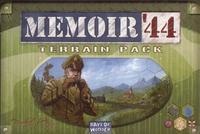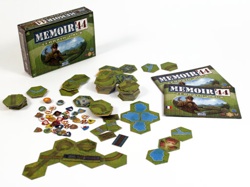
|
About OgreCave and its staff
|

|
by Daron Patton
Memoir '44 is a very visually-oriented WWII game, providing an abstract take on various battles between the Axis and Allies. One way of enhancing that theme is through the use of the many different gameboards and terrain pieces published by Days of Wonder. While many scenarios can be played on the double-sided countryside/beach assault board included with the base game, building a collection adds a lot to the tone of the game. The feel of playing on a snow covered board with snow-covered forests, for example, really adds to the intensity of the game when you're pitting Germans against Russians on the Eastern Front.
New Fields of Battle The desert tiles include oases, palm forests, desert villages, and wadis. The forests and villages are treated as they would be in the base game but provide a consistent desert background if players want to buy the desert/winter boards expansion. The Oasis tiles can be used to improve a unit's defense or even to recover lost infantry units in certain scenarios (healing waters, as it were). Wadis are naturally formed gulleys or trenches that channel movement; units can travel through a wadi without problem, but trying to cross the wadi's steep sloped walls is impossible for any unit. To represent delaying tactics used by the Germans later in the war – specifically, flooding areas to hinder armor movement – there are Flooded Fields scenarios. In these scenarios, basic board hexes are considered to be muddy, soggy messes caused by intentional flooding. High Ground tiles are used to represent areas that are not quite hills but not low enough to be flooded. Marsh tiles are also provided and have similar effects to Flooded Fields but in more limited spaces.
The Victoria Cross and Italian Medal for Military Valor are included to help individualize games where British and Italian forces are in play. Other badges help identify combat engineers and other special units from various countries that fought in WWII. Badges are included to help identify British, Polish, Yugoslav, Spanish, Italian, Australian, New Zealander, Gurkha, German (including Afrika Korps), and American (101st) troops. These nationality badges are very helpful in the more advanced scenarios that differentiate the specific forces involved in the actual battles. Battle Star Tokens are round tokens with stars printed on them. Depending on the mission, Battle Star Tokens can represent prisoners, captured equipment, collapsible boats/rafts, sabotage targets and heroic leaders. The boats temporarily (one use) allow infantry to navigate waterways that might otherwise be impassible, for example. Rules for all of these extra actions are provided in the rules booklet and apply in missions that specify them in their write-up. Beyond the previous terrain types, there are several landmarks provided to enhance mission play and which tie in to the Battle Star Tokens in many cases. Dams, power plants and factory complexes can be the targets of sabotage. Airfields can be captured or used for landing reinforcements. Barracks, churches, lighthouses and cemeteries provide village-like effects along with benefits like artillery spotting advantages (depending on mission requirements); their varied artwork can also improve the customizability of the board's appearance. A radar station, if owned, can impact your opponent's flexibility on playing the Air Power card. Supply Depots, if destroyed, can reduce enemy tank unit movements (due to fuel being harder to come by). Field bunkers, river fords, pontoon and railroad bridges, roadblocks and even locomotives are also included. Pontoon bridges may be erected instead of activating units via an Attack command card (sacrificing a potential attack for improved mobility over a river). Railroad bridges can span terrain that railroads do not but are otherwise treated the same, including their slowing down of armor units. Bridges aside, the trains are kind of neat all by themselves. Depending on scenario rules, they can function as mobile artillery platforms, sources of unit reinforcements or objectives to be destroyed. Artillery in some scenarios may be amped up to "Big Guns." This represents both larger caliber artillery and improved communication by forward observers. Big guns have increased range from regular artillery. They are also effective at punishing hexes where they previously scored one or more hits without wiping out all target units. A marker is placed in such a space, and if the target unit remains in place, the Big Gun will be able to roll an additional die. Only moving out of the targeted hex or being destroyed remove this effect. Up to three separate hexes can have this effect on-going from a Big Gun. Minefield rules, which are also provided in the Eastern Front expansion, are introduced and markers for setting them up are included. Thanks to inverted counters, enemy units entering minefields do not know how strong the minefield will be until they enter it. It may be a decoy, causing no damage, or it may cause 1-4 dice to be rolled against the affected unit. Grenades and the unit's symbol cause casualties if rolled. Once a minefield has been triggered, it remains in play but its strength remains visible, the token staying number side up. Friendly units can traverse their own minefields but have to stop immediately upon entering. Scenarios included are Battle of Gazala (Knightsbridge); Market Garden (Nijmegen Bridges); Schwammenauel Dam; and Operation Grenade (River Roer). Gazala is a tank battle in the desert that introduces wadis and oasis tiles to the game but is largely open desert terrain. Gazala also presents North Africa Desert rules, which make tanks more mobile, especially during attacks and overruns. Market Garden is chock full of terrain, including railroads, rivers, forests and towns. Allies use Battle Star Tokens to equip some of their infantry with collapsible one-use boats that are helpful in crossing the river, while the Germans have a Big Gun unit to back their largely infantry-based defense. The Schwammenauel Dam mission pits dam-sabotaging Germans against the Allies in a terrain dominated by forests, mountains, and the River Roer with two dams. The final mission, Operation Grenade, features a receded river (fordable by the Allies) and a German defense backed with by several minefields.
Conclusions Links:
|
||||
 Memoir '44 Terrain Pack (2005)
Memoir '44 Terrain Pack (2005) Mountains, roads, railways and rivers/waterways are also provided.
Mountains are similar to hills in effect except they add another level
for game consideration by being higher. Roads grant movement bonuses,
while railroads slow down armor and are used in certain scenarios where
railroads played an important role. The rivers and waterways are
welcome additions. The lake pieces let you make a proper lake instead
of proxying lakes with rivers as you have to do if you only have the
base set; there's obviously nothing wrong with using river sections to
make a lake (as the base set rules demonstrate), but the Terrain Pack
hexes make the board look just that much nicer.
Mountains, roads, railways and rivers/waterways are also provided.
Mountains are similar to hills in effect except they add another level
for game consideration by being higher. Roads grant movement bonuses,
while railroads slow down armor and are used in certain scenarios where
railroads played an important role. The rivers and waterways are
welcome additions. The lake pieces let you make a proper lake instead
of proxying lakes with rivers as you have to do if you only have the
base set; there's obviously nothing wrong with using river sections to
make a lake (as the base set rules demonstrate), but the Terrain Pack
hexes make the board look just that much nicer.